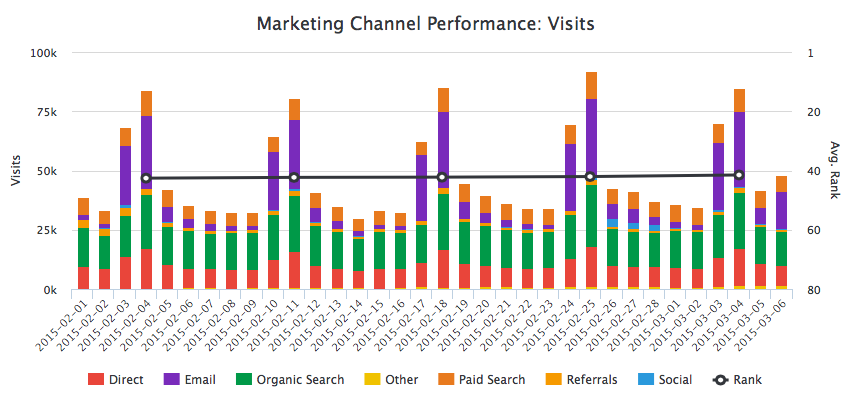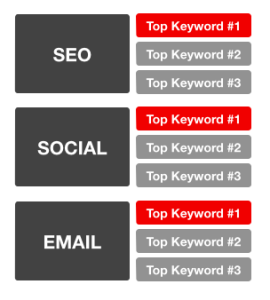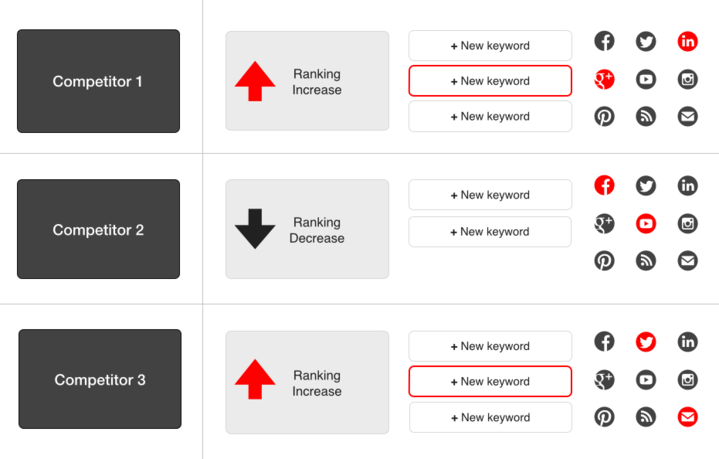According to Content Marketing Institute, only 28% of marketers report being successful at tracking the ROI of content marketing programs. This leaves a number of marketers who are either not attempting to track their content marketing at all, or are trying and still feel unsuccessful.
Although there are many ways to slice the proverbial analytics pie, getting the most out of your marketing intelligence can often be achieved by simplifying your view and focusing on a few actionable metrics. Here are five that you can start using now to improve your content performance.
- Marketing channel performance
- Keyword/topic performance and ranking
- All organic traffic vs. tracked organic traffic
- Return visits vs. new visitors
- Competitor performance vs. your performance
Marketing Channel Performance
Channel performance metrics are key to understanding how you’re driving traffic for your brand. Ask yourself: Where are you distributing your content? If you’re like most marketers, you’re using a mix of email, social, search, paid options, and referrals to bring visitors to your site and content. Knowing which channels are working best for you can help to focus your efforts. Beyond knowing what’s working overall, you should also be able to focus on what’s working by specific segments, such as by campaign, product, audience persona, or geography.

Don’t fall into the trap of simply looking at how many visitors have come to your content. Although those numbers are important, they don’t tell the whole story and they can’t really help identify problems and inform future decisions. Look beyond visitor totals to where those visitors came from, how they found you, and how the types of content they’re consuming differ from channel to channel.
You will also need to pay attention to whether or not channels contribute to conversions and revenue. Adding lots of followers or amassing traffic will do little if those audience members never take another action with your brand. For instance, which social channel works best for a particular campaign? Maybe you’re getting great traffic on Twitter but real conversions from people on Pinterest. If you find you’re getting a lot of conversions from Pinterest, maybe you’ll want to create more visual content and try to create an Instagram following, as well.
Watching channel performance over time will tell you a lot about your content landing pages. Maybe it’s time to update them to create more interest or a better spot in the search engine rankings. It will also tell you how well your link building strategies are working and how much traffic is coming from other popular sites as indicated on the referral channel results.
Depending on your business, you may want to get daily tracking results from all or some of these channels:
- Search
- Social Media
- Referral
- Display
- Paid Search
- Direct
- Comparison Shopping Engine
- Mobile
- Affiliate
Keyword Performance and Ranking
At their simplest level, keywords and topics can be tracked and ranked according to which keywords help you reach your target audience. Tracking only individual keywords will give you limited results and may not reflect how your efforts are impacting overall business objectives. Instead, create keyword and topic groups. One advantage of measuring keywords groups is the ability to capture the keywords as they are used in long-tail search. You can also track your keyword groups by specific campaigns or product features. It’s helpful to look at keyword groups for the following:
- Campaigns
- Products
- Brands
- Geography
- Features
- Competitors
Keep in mind that keyword / topic groups can include phrases as well as individual words, and that phrase search is much more common and likely to yield more precise audience – content matches.
Once you start tracking keyword groups and monitoring your results for individual campaigns or features, you’ll want to keep that list updated. GinzaMetrics gives you the ability to discover new keywords and topics that are already driving traffic to your site and recommend keywords you should be using, but aren’t. Knowing how easily you and your content can be found using your target keywords will give you the insights you need to optimize your current content and make future content decisions.
Monitor top keyword activity for you and your competitors to know what content is driving traffic to your site and to your competitor’s site. If your competitor isgaining share of mind with certain keywords, you’ll want to create better content to win your audiences back.
All Organic Visits vs. Tracked Organic Visits
Day to day, week to week, month to month, you’ll want to track and compare the total number of organic visits to your site. You’ll also want to know where those visitors came from. Which search engines are giving you the biggest return? Which devices are people using most to find you? These are all metrics that will help you make decisions about where to spend advertising dollars and how to optimize your messages for the devices people are using when they search for your solution.
Beyond that, you’ll want to compare your total number of organic visits to the number of visits from the keywords you’re using and tracking. If you find that your tracked organic visits are lagging too far behind your organic visits, do some keyword discovery to find out what keywords you aren’t using, but should. This comparison is key to keeping up with your target audience and understanding what they’re looking for when they find you. Keyword discovery is where you’ll find your email subject lines and content ideas to address your audience’s needs.
Return Visits vs. New Visitors
There are a few key goals for content marketing: getting new leads and new customers, retaining existing customers, and creating evangelists for your brand. Knowing which efforts are driving new visitors to your site is as important as knowing how many visitors return for more content. When measuring the visitors to your site, it’s useful to look at two types of visitors:
Return visitors: these are your loyal following or people who are interested in your content, those who come back to your website for your latest blog post or to consume new content. These are the people you are keeping your website pages updated for and creating new content for on a regular basis.
New visitors: these are your newly won audience members. New visitors can be an indication that you have increased your audience reach. Pay attention to where these folks are coming from and what they are consuming once they get to your site. You want to keep doing what’s working and increase your efforts on those things that are most successful.
Competitor Performance vs. Your Performance
Competitor intelligence answers these questions:
- What type of marketing and content creation are competitors doing?
- On which channels are they creating and distributing the content to your shared audience?
- How are these marketing efforts working for them?
- Are they getting a bigger piece of the audience pie and from where?
A common mistake we make as marketers is take a glimpse into our competitor’s performance on a yearly basis and then assume we’ve maintained our position over time. Things change quickly and new competitors pop up all the time. In addition, your existing competitors may change their strategy or add a micro site that competes directly with your messaging. Know what your competitors are up to – track daily and report regularly.
Know who your audiences are discovering more often when they search for your keywords and topics. Are they finding you or your competitors? When you know what content your competition is having the most success with, you can compare your efforts and adjust your messages to more closely match what your target audience is looking for when they search for a solution to their problem. Although you don’t want to copy your competitor’s content, you can get a sense of the messages that are resonating with your audience and adjust your content accordingly.
If you find that your competition is more popular on a particular social media channel, you’ll want to focus some effort into developing your presence on that channel, or making sure that the content you’re delivering to that channel is the type of content that audiences are looking for. Staying ahead of existing competition and discovering new competitors as they enter your market gives you the intelligence you need to make strategic moves before you lose audience share.
KPIs and Business Goals
No matter what metrics you’re watching, you’ll want to report on KPIs and progress toward business goals. Although there are a lot of different factors that lead to conversions and new customers, your content marketing efforts have an impact on these metrics.
Setting up your dashboard to measure specific conversions, segment by campaign and keyword group, and view by things such as device or search engine can make sure you’re accurately tracking efforts toward KPIs.
Share this data with your team and executives and explain how your efforts have contributed to these results and how you can leverage insights to drive additional conversions and revenue in the future.
If you would like to know more about how GinzaMetrics can help you to track these five essential metrics, give us a shout and we’ll show you around the platform.



